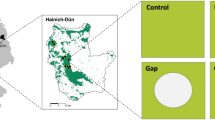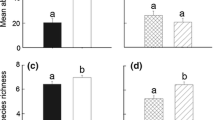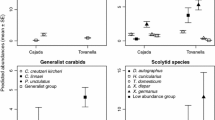Abstract
Intensive management of boreal forests has replaced natural disturbances, leading to losses of residual deadwood and saproxylic biodiversity. Declining population sizes have been well documented for insect groups such as bark and wood-boring beetles, whilst other groups such as flat bugs (Heteroptera: Aradidae) are less well-studied and little is known about their response to forest restoration. We conducted two restoration experiments addressing this lack of knowledge. We predicted the following responses to restoration: (1) artificial gap-creation and prescribed burning will attract more flat bugs than control stands, (2) increasing pre-burning fuel loads will have a positive influence on flat bug response to fire restoration. To test these predictions we conducted two field experiments; in Sweden we compared prescribed burning of standing forest with artificial gap-creation and in Finland we compared differing levels of fuel-load prior to burning. We found partial support for our first prediction, total numbers of flat bugs collected was higher in burned forest stands compared to controls in both countries. By contrast, gap-cutting only resulted in a marginal increase in the numbers and species of flat bugs collected. We found no support for our second hypothesis. The red-listed Aradus angularis and A. laeviusculus were primarily found in burned stands. Aradus betulae, A. betulinus and A. lugubris were more frequent in burned stands than gap-cuttings and untreated controls. Our study therefore suggests that ecological restoration, especially burning, is an efficient way of attracting flat bugs to suitable habitat, we therefore recommend ecological restoration to be incorporated in boreal forest management.

Similar content being viewed by others
References
Ahti T, Hämet-Ahti L, Jalas J (1968) Vegetation zones and their sections in north-western Europe. Ann Bot Fenn 5:169–211
Angelstam PK (1998) Maintaining and restoring biodiversity in European boreal forests by developing natural disturbance regimes. J Veg Sci 9:593–602
Bates D, Maechler M, Bolker B, Walker S (2015) Fitting linear mixed-effects models using lme4. J Stat Softw 67(1):1–48
Chapin FS, Zavaleta ES, Eviner VT et al (2000) Consequences of changing biodiversity. Nature 405:234–242
Core Team R (2014) R: a language and environment for statistical computing. R Foundation for Statistical Computing, Vienna
Coulianos CC (1989) New provincial records of bark stinkbugs (Hem.-Het., Aradidae) together with Aradus truncatus, new for Sweden. Entomologisk Tidskrift 110:53–57
Department of forest resource management (2014) Aktuella uppgifter om de svenska skogarna från Riksskogstaxeringen. Tema: Biologisk mångfald. SLU. Umeå
Deyrup M, Mosley JG (2004) Natural history of the flat bug Aradus gracilicornis in fire-killed pines (Heteroptera: Aradidae). Fla Entomol 87:79–81
Edenius L (2011) Short-term effects of wildfire on bird assemblages in old pine- and spruce-dominated forests in northern Sweden. Ornis Fennica 88:71–79
Ehnström B, Axelsson R (2002) Insektsgnag i ved och bark. ArtDatabanken, SLU, Uppsala
Esseen P-A, Ehnstrom B, Ericson L, Sjoberg K (1997) Boreal forests. Ecol Bull 46:16–47
Finnish Forest Research Institute (2011) Finnish statistical yearbook of forestry. Finnish forest research institute, Sastamala
Foley JA, DeFries R, Asner GP et al (2005) Global consequences of land use. Science 309:570–574
Fraver S, Ringvall A, Jonsson BG (2007) Refining volume estimates of down woody debris. Can J For Res 37:627–633
Froeschner RC (1988) Family Aradidae Spinola, 1837, the flat bugs. In: Henry TJ, Froeshner RC (eds) Catalogue of the Heteroptera, or true bugs, of Canada and the continental US. E J Brill, USA
Gärdenfors U (2010) Rödlistade arter i Sverige 2010 - The 2010 Red List of Swedish Species. ArtDatabanken SLU, Uppsala
Geldmann J, Joppa LN, Burgess ND (2014) Mapping change in human pressure globally on land and within protected areas. Conserv Biol 28:1604–1616
Gonzales E (2013) Restoration ecology: the new frontier. Conserv Biol 27:433–435
Gossner MM, Engel H, Blaschke M (2007) Factors determining the occurrence of flat bugs (Aradidae) in beech dominated forests. Waldoekologie 4:59–89
Gustafsson L, Baker SC, Bauhus J et al (2012) Retention forestry to maintain multifunctional forests: a world perspective. Bioscience 62:633–645
Heinonen J (1994) Koealojen puu- ja puustotunnusten laskentaohjelma KPL: Käyttöohje [Manual for KPL: a calculation program for tree and stand characteristics]. Metsäntutkimuslaitoksen tiedonantoja 504 (In Finnish)
Hekkala A-M, Päätalo M-L, Tarvainen O, Tolvanen A (2014a) Restoration of young forests in eastern Finland: benefits for saproxylic beetles (Coleoptera). Restor Ecol 22:151–159
Hekkala A-M, Tarvainen O, Tolvanen A (2014b) Dynamics of understory vegetation after restoration of natural characteristics in the boreal forests in Finland. For Ecol Manag 330:55–66
Heliövaara K, Väisänen R (1983) Environmental-changes and the flat bugs (Heteroptera, Aradidae and Aneuridae)—distribution and abundance in eastern Fennoscandia. Ann Entomol Fenn 49:103–109
Hjältén J, Atlegrim O, Sandstöm F, Pettersson R, Rexstad EA (2006) Occurence of flat bugs (Heteroptera: Aradidae) in burned and unburned forests. Entomol Fennica 17:130–135
Hothorn T, Bretz F, Westfall P (2008) Simultaneous inference in general parametric models. Biometrical J 50:346–363
Johansson T, Hjältén J, Stenbacka F, Dynesius M (2010) Responses of eight boreal flat bug (Heteroptera: Aradidae) species to clear-cutting and forest fire. J Insect Conserv 14:3–9
Johansson T, Hjältén J, de Jong J, von Stedingk H (2013) Environmental considerations from legislation and certification in managed forest stands: a review of their importance for biodiversity. For Ecol Manag 303:98–112
Klocke D, Schmitz H (2012) Material properties of photomechanical infrared receptors in pyrophilous Melanophila beetles and Aradus bugs. Acta Biomate 8:3392–3399
Koch K (1989a) Die Käfer Mitteleuropas: Ökologie, vol 1. Goecke & Evers Verlag, Krefeld
Koch K (1989b) Die Käfer Mitteleuropas: Ökologie, vol 2. Goecke & Evers Verlag, Krefeld
Koch K (1992) Die Käfer Mitteleuropas: Ökologie, vol 3. Goecke & Evers Verlag, Krefeld
Kouki J, Hyvärinen E, Lappalainen H, Martikainen P, Similä M (2012) Landscape context affects the success of habitat restoration: large-scale colonization patterns of saproxylic and fire-associated species in boreal forests. Divers Distrib 18:348–355
Kuuluvainen T, Grenfell R (2012) Natural disturbance emulation in boreal forest ecosystem management—theories, strategies, and a comparison with conventional even-aged management. Can J For Res 42:1185–1203
Laasasenaho J (1982) Taper curve functions for pine, spruce and birch. Commun Inst For Fenn 108:1–74
Lappalainen H, Simola H (1998) The fire-adapted flatbug Aradus laeviusculus Reuter (Heteroptera, Aradidae) rediscovered in Finland (North Karelia, Koli National Park). Entomol Fennica 9:3–4
Lindenmayer DB, Franklin JF, Fischer J (2006) General management principles and a checklist of strategies to guide forest biodiversity conservation. Biol Conserv 131:433–445
Lindhe A, Jeppsson T, Ehnstrom B (2011) Longhorn beetles in Sweden—changes in distribution and abundance over the last two hundred years. Entomologisk Tidskrift 131(241):244–507
Lundberg S (1984) The beetle fauna of burnt forest in Sweden. Entomologisk Tidskrift 105:129–141
Olsson J, Jonsson BG (2010) Restoration fire and wood-inhabiting fungi in a Swedish Pinus sylvestris forest. For Ecol Manag 259:1971–1980
Pasanen H, Junninen K, Kouki J (2014) Restoring dead wood in forests diversifies wood-decaying fungal assemblages but does not quickly benefit red-listed species. For Ecol Manag 312:92–100
Perhans K, Glode D, Gilbertsson J, Persson A, Gustafsson L (2011) Fine-scale conservation planning outside of reserves: cost-effective selection of retention patches at final harvest. Ecol Econ 70:771–777
Pettersson R (2011) Inventering av brandgynnade insekter i Västerbottens län 2005-2006. Meddelande 8. Länstyrelsen Västerbotten, Umeå
Pettersson R, Nilsson A (1986) Några nordsvenska fynd av barkstinkflyn med Aradus angularis J. Sahlberg ny för landet. Entomologisk Tidskrift 107:112–114
Pettersson RB, Stenbacka F, Hjältén J, Hilszczanski J (2007) Återfynd av rödhalsad brunbagge (Phryganophilus ruficollis Fabr.) och Huggerts plattbrackstekel (Chartobracon hugerti C. van Achterberg). Entomol Tidskr 128:101–105
Pinheiro J, Bates D, DebRoy S, Sarkar D, R Core Team (2015) nlme: linear and nonlinear mixed effects models. R package version 3.1-122
Ranius T, Bohman P, Hedgren O, Wikars L-O, Caruso A (2014) Metapopulation dynamics of a beetle species confined to burned forest sites in a managed forest region. Ecography 37:797–804
Rassi P, Hyvärinen E, Juslén A, Mannerkoski I (2010) The 2000 red list of Finnish species. Ympäristöministeriö & Suomen ympäristökeskus, Helsinki
Rintala T, Rinne V (2010) Suomen Luteet [Finnish Bugs]. Hyönteistarvike Tibiale, Helsinki
Rouvinen S, Kuuluvainen T, Karjalainen L (2002) Coarse woody debris in old Pinus sylvestris dominated forests along a geographic and human impact gradient in boreal Fennoscandia. Can J For Res 32(2184):2200
Schmitz A, Schatzel H, Schmitz H (2010) Distribution and functional morphology of photomechanic infrared sensilla in flat bugs of the genus Aradus (Heteroptera, Aradidae). Arthropod Struct Dev 39:17–25
Seibold S, Bässler C, Baldrian P, Thorn S, Müller J, Gossner MM (2014) Wood resource and not fungi attract early-successional saproxylic species of Heteroptera—an experimental approach. Insect Conserv Diver 7:533–542
Shorohova E, Kneeshaw D, Kuuluvainen T, Gauthier S (2011) Variability and dynamics of old-growth forests in the circumboreal zone: implications for conservation, restoration and management. Silva Fenn 45:785–806
Siitonen J (2001) Forest management, coarse woody debris and saproxylic organisms: Fennoscandian boreal forests as an example. Ecol Bull 49:11–41
Speight MCD (1989) Saproxylic invertebrates and their conservation. In: Nature and environment series, vol Y42, pp 79. Council of Europe, Publication and Documnets Division, Strasbourg
Stokland JN, Siitonen J, Jonsson BG (2012) Biodiversity in dead wood. Cambridge University Press, Cambridge
Sverdrup-Thygeson A, Gustafsson L, Kouki J (2014) Spatial and temporal scales relevant for conservation of dead-wood associated species: current status and perspectives. Biodivers Conserv 23:513–535
Taylor SJ (1988) Skototaxis in 3 species of flat bugs (Heteroptera, Aradidae). Ann Entomol Soc Am 81:537–538
Timonen J, Siitonen J, Gustafsson L, Kotiaho JS, Stokland JN, Sverdrup-Thygeson A, Mönkkönen M (2010) Woodland key habitats in northern Europe: concepts, inventory and protection. Scand J For Res 25:309–324
Toivanen T, Kotiaho JS (2007) Mimicking natural disturbances of boreal forests: the effects of controlled burning and creating dead wood on beetle diversity. Biodivers Conserv 16:3193–3211
Uotila A, Maltamo M, Uuttera J, Isomäki A (2002) Stand structure in semi-natural and managed forests in eastern Finland and Russian Karelia. Ecol Bull 49:149–158
Viiri H, Eerikäinen K (2012) Red-listed Aradus laeviusculus (Hemiptera: Aradidae) inhabits burnt restoration sites in the Koli National Park, North Karelia, Finland. Entomol Fennica 23:63–68
Vitousek PM (1997) Human domination of earth’s ecosystems. Science 277:494–499
Wallenius T, Niskanen L, Virtanen T et al (2010) Loss of habitats, naturalness and species diversity in Eurasian forest landscapes. Ecol Indic 10:1093–1101
Wikars L-O (2001) The wood-decaying fungus Daldinia loculata (Xylariaceae) as an indicator of fire-dependent insects. Ecol Bull 49:263–268
Wikars L-O (2006) Åtgärdsprogram för bevarande av brandinsekter i boreal skog. Rapport nr. 5610. Naturvårdverket, Stockholm
Wyniger D, Moretti M, Duelli P (2002) Aradus lugubris Fallen, 1807 (Hemiptera, Heteroptera, Aradidae) in a chestnut forest of Southern Switzerland after a fire experiment. Mitteilungen der Schweizerischen Entomologischen Gesellschaft 75:61–64
Ylisirniö AL, Penttilä R, Berglund H et al (2012) Dead wood and polypore diversity in natural post-fire succession forests and managed stands—lessons for biodiversity management in boreal forests. For Ecol Manag 286:16–27
Acknowledgments
The Finnish restoration measures were carried out as part of the Green Belt LIFE (LIFE04 NAT/FI/000078) project. Staff of the Finnish Forest Research Institute [presently Natural Resources Institute Finland (Luke)] and Metsähallitus carried out the restoration measures. Trainees in Finnish Forest Research Institute helped in flat bug collecting and sorting. Petri Martikainen identified the Finnish specimens of flat bugs. Maj & Tor Nessling foundation provided a personal scholarship for A.-M.H. The Swedish part of the study was financed by the Swedish research council Formas, Kempe stiftelserna. Holmen AB conducted the restoration measures as well as acted as land hosts. Field personnel at the Department of Wildlife, Fish and Environmental studies, SLU helped out with sampling of flatbugs and measuring living and dead trees. Roger Pettersson helped out with the identification of the Swedish flatbugs and Timothy Work helped to improve the language in the text. We would also like to thank the two anonymous referees for their constructive critique and helpful suggestions.
Author information
Authors and Affiliations
Corresponding author
Rights and permissions
About this article
Cite this article
Hägglund, R., Hekkala, AM., Hjältén, J. et al. Positive effects of ecological restoration on rare and threatened flat bugs (Heteroptera: Aradidae). J Insect Conserv 19, 1089–1099 (2015). https://doi.org/10.1007/s10841-015-9824-z
Received:
Accepted:
Published:
Issue Date:
DOI: https://doi.org/10.1007/s10841-015-9824-z




